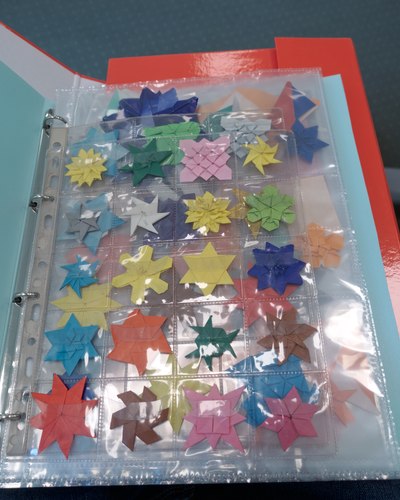Models folded by Shuzo Fujimoto himself

I only mentioned them in passing in one of my previous posts so now I want to expand a little upon the subject of models folded by Shuzo Fujimoto himself that I received from Roberto Morassi.
Morassi exchanged letters with Fujimoto starting from the 1980-s, and received from him also folding instructions, books, and a number of models. At the end of 2022, shortly after the celebrations of Fujimoto’s centenary, Roberto approached me and asked if I would like to become some of these treasures’ custodian, to which I reluctantly agreed. Since sending such unique items by post might be risky, we devised another way of getting them from Italy to Poland. Robin Scholz agreed to be our courier, since he planned to attend both the Italian and German origami conventions. He picked up the models from Roberto at the Italian convention, and handed them over to me at the German convention.
The package contains models, letters, folding instructions, and a photograph. So far, I have only analyzed its contents roughly, but I already recognize that it is a real treasure trove for research on Shuzo Fujimoto. I can identify many models and match them to entries in my Catalog of Fujimoto’s Works (CFW), but some are new. I haven’t cataloged them yet, but they have already provided answers to a few questions that I couldn’t resolve otherwise.
For example, I recently started work on those models in CFW, for which no image of the finished model is available in any of my sources. Some models are only described textually, and automatic translation tools often produce English translations which are very hard to understand. I recognized one of the models from Roberto’s package as matching the description for CFW 97: it confirmed that my understanding was almost correct, the difference being that when shaping the flower’s petals, Fujimoto folded the sides in front of the petals rather than behind as I had expected.
Thanks to this package, I also noticed a design that I had almost missed while analyzing Fujimoto’s books: CFW 54. It is the same as my Propellers Tessellation, just designed by Fujimoto some 30 years before me. In the books, only a single molecule of this tessellation appears in a picture of a more complex tessellation built from different molecules. It is back-lit, and the picture is of poor quality, so I was not sure if it was the same, but the physical model confirms it is.
These models have also confirmed some guesses that I had to make when reverse-engineering models based on drawings in the books. For many stars, Fujimoto’s old books only show the beginning twist and the end result, and on top of that, drawings of finished model do not show layer ordering. This means having to fill in lots of gaps, and some steps can be solved in more than one way. Fortunately, so far these models confirm my educated guesses, but I expect some surprises to also pop up once I analyze them in more detail.
Finally, these models say a lot about Fujimoto’s approach to origami. On one hand, they confirm what I have heard from people who interacted with him: he did not care about the neatness of folding at all. Papers are not very good, and folding quality is, frankly, poor. For Fujimoto, it was the design that mattered. A physical paper model was just a visualisation of that abstract idea, and he didn’t care about its quality. On the other hand, these models show Fujimoto’s immense creativity, and that he liked tinkering, and finding new combinations of models. We see tessellations made from different kinds of molecules, various combinations of elements of different stars, minor variants of models that I haven’t seen in the books, etc. This will be an important source of information for the Catalog, and letters will certainly also shed new light on some elements of Fujimoto’s work. Roberto Morassi has agreed for the letters to be digitized and published as well as the models.
I am very grateful to Roberto Morassi for entrusting me with these models and letters. I hope to make good use of them so that we expand our knowledge of Shuzo Fujimoto’s origami.
Comments